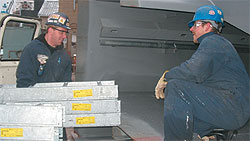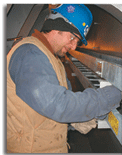|
March 2005 IBEW
Journal
<< To
Page 1
The new machinery that
will handle bulk cargo needs power. Machine operators
need light.
Enter the IBEW. Members
of Local
303 work for Canal Marine, an electrical
mechanical contractor located in St. Catharines
between Lake Ontario and Lake Erie, approximately
10 minutes from Niagara Falls. Canal, a long-time
union employer, has designed and installed the electrical
systems for many self-unloading ships, including
recent projects for Norwegian and Korean shipping
firms.

Local 303 members (L-R) Graeme Adams
and Marty
DeMoel load ladder tray into tunnel unit at pre-outfit
state. |
Local
303 members wire the new unloading systema
single conveyor belt, driven by two 400-horsepower
motors that will offload cargo at a rate of approximately
4,000 to 4,400 tons per hour, depending upon
the type of payload. Canals crews supply power
to the gleaming cranes, winches and booms. Wiremen
pull nine runs of 750 mcm (1,000 circular mils.
in diameter) single-conductor cable, totaling
7,400-feet, to feed the bow thruster motor that
will help pilots safely dock the ship. Journeymen
install programmable logic controllers to guide
the sensors that will report on belt weight and
ballast tank levels. Members hook up 48 hydraulic
solenoids (electromagnets) to control the position
of the gates that will hold back and release
the surges of future stowage. Over 140 fluorescent
fixtures are installed. Four closed circuit television
cameras are mounted high for crews to monitor
the unloading process, which is controlled by
two main computers. One directs unloading; one
maintains ballast.
 |
 |
Left
- Local 303 member Chris Tirpko installs cable
tray in tunnel of Hull No. 80. |
|
 |
 |
Local
303 member Greg Luchyshyn prepares to drill bulkhead |
 |
| |
 |
 |
Ship refurbishing is dangerous
work. The trades, which supply approximately 240
members for nine months on the project, bargained
for safety representatives on each shift and a full
time nurse. They address problems immediately. Serious
accidents are rare.
Riganelli has worked on
about four ship-refurbishing projects that take approximately
one year to complete. Hes been there with his crews
of 15 to 25at peak staffingin the arctic-like winters,
when the hull acts as a wind tunnel, and in the muggy
summers. Its all worth it, he says, when members
see one of the updated vessels travel through the
Welland Canal, in its own working environment.
Pride and tradition are
inseparable in the worlds shipyards. On December
8, 2004, the trades at Port Weller Dry Docks were
out in force at a keel-laying ceremony for Hull No.
80.
Celebrations surrounding
the laying of the keel originated centuries ago when
ships were made of wood. Placement of the keel, the
long timber forming the "backbone" of a
vessel, was the first step in its construction. Today,
construction materials, techniques and equipment
have changed, but keel-laying ceremonies carry on
to rejoice in workmanship and team effort.
On December 8, as "The
Clyde" installed the first of several steel
units of Hull No. 80s keel, presidents of the shipbuilding
and dry dock companies placed a silver dollar under
the unit. It was the first of two ceremonies that
will lead to a new name for the refurbished freighter.
In June, when Hull No.
80s construction is complete, and the dry dock is
flooded, the vessel will be pulled out by tugboats
and docked at a tie-up wall for christening. The
silver dollar will be removed and given to the person
who breaks the ceremonial bottle of champagne on
the bow, revealing the new name. A minister will
bless the ship before it sails on its maiden voyage.
Pete Riganelli and his
crew will be there, proud to carry on a tradition
of IBEW craftsmanship, and ready for their next makeover
patient.

|
